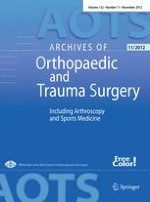Published in:

01-11-2012 | Orthopaedic Surgery
Full-endoscopic interlaminar approach for the surgical treatment of lumbar disc herniation: the causes and prophylaxis of conversion to open
Authors:
Bing Wang, Guohua Lü, Weidong Liu, Ivan Cheng, Alpesh A. Patel
Published in:
Archives of Orthopaedic and Trauma Surgery
|
Issue 11/2012
Login to get access
Abstract
Study design
Retrospective case series.
Objective
To analyze the causes of conversion to open for the surgical treatment of lumbar disc herniation with use of full endoscopic (FE) technique, and prophylaxis of conversion to open also proposed.
Method
50 patients with lumbar disc herniation underwent discectomy using unilateral portal FE interlaminar approach collected from August 2008 to August 2010. All FE operations were performed under general anesthesia and endotracheal intubation. According to the level incision of the ligament flavum, the starting point of nerve root at the dura under endoscopic view was classified as: Type I (starting point of the nerve root was higher than the incision) and Type II (the starting point of nerve root was lower than the incision). The causes and effective prophylactic measurements for cases of conversion to open were analyzed.
Results
There were 47 cases classified as Type I for a rate of 94 %, and Type II in 3 cases for a rate of 6 %. Five cases were converted to open surgery, and the conversion rate was 10 %. There were three males and two females with a mean age of 36.2 (29–44) years, the average duration of symptoms was 58.4 (35–105) days. The level was L5–S1 in four cases and L4–5 in one, lateral extrusion in three cases, paracentral extrusion in one, and sequestration in one. Leg pain resolved in three cases and improved in two after open surgery. Of five cases of conversion to open, misplacement of the working portal occurred in one case (Type I). Difficult dissection of nerve root and hemostasis resulting in open conversion occurred in one case (Type II); this patient sustained a dural injury. The nerve root could not be exposed in three cases (Type II), the FE changed to open finally. During the open procedure with Type II, we found that the location of origin of the nerve root was caudal to the inferior laminar edge. Therefore, partial removal of bony structures along lateral recess was necessary in order to visualize the nerve root.
Conclusion
Misplacement of working portal during the exposure of the ligament flavum and difficulty in indentifying anatomy are potential causes for conversion to open in the initial adoption of FE technique. However, uncommon conditions such as variation of the nerve root origin can also result in conversion to open in experienced hands. Endoscopic experience, proper patient selection and specific radiographic examination are needed to obtain optimal outcomes using a full endoscopic technique for microdiscectomies.





